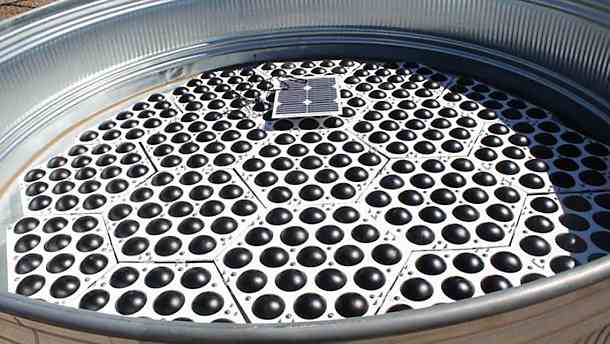Looking to solve the evaporation of water from bodies of water, such as mining tailings, reservoirs and ponds, a new technology, called Hexocover, was invented at the University of Arizona. Simultaneously generating energy reserves with the use of solar panels, the invention consists of hexagonal-shaped modular floating cover panels that are made from UV inhibited recyclable plastic and arranged to fit individual water surface dimensions and form a cover over the water.

Commenting on the purpose of the technology, the university’s renewable energy network director, Ardeth Barnhart, said “Mining activity typically requires a lot of energy. This technology is a great example of how original ideas that develop the use of solar energy to transform industrial processes can have immediate and transformative effects on water and energy use, create positive environmental impact and provide direct benefits to our economy.”
The Hexocover was developed by Moe Momayez from the university’s Department of Mining and Geological Engineering and Nathan Barba from RePower Design as a result of their effort to find a solution to water conservation in mining tailings and ponds. Their project was commended by “Mining Global”, who wrote that this technology has untapped potential for the industry, stating, “The new technology will offer a combination of positive environmental impact by minimizing water evaporation, which is costly for mining companies to replace, as well as generating electricity.”
This invention was also realized with the help of Tech Launch Arizona, which worked with Barba’s company and executed an exclusive license for it that granted RePower Design the sole right for the commercialization of the technology, which includes the solar panel integration and the floating panel design.
The inspiration came from the fact that Tucson has an evaporation rate of 109 inches per year and its constant need to replenish water in its reservoirs and storage facilities. Also, Momayez has been investigating the integration of PV panel deployment in reclamation and mining processes, the effects of mining on PV output efficiency and the geotechnical considerations related to installing these panels on tailing slopes.
“We needed a way to prevent the evaporation of (tailing pond) water, but we needed a system that could move out of the way when the tailings are being released into the ponds,” stated Barba. “If we can cover them, we can help with the devastating water shortage problem here in the southwestern U.S. and around the world. For someone who owns water reservoir, like a mine or municipality, this invention provides a dual benefit and a dual revenue stream.
As for Momayez, he stated, “The PV work on reclaimed mining lands has gained national recognition and the idea to control the evaporation of the supernatant water accumulating in the middle of tailing storage facilities was a natural extension of my research and a huge step forward to save water in arid climates worldwide.”
According to research, the mining industry has been historically slow to adopt renewable energy technology. However, it forecasts that renewable energy technologies will supply between 5 and 8% of the mining industry’s power consumption by 2022 throughout the world. In addition, these technologies, particularly the Hexocover, would minimize the overall impact of mining on the environment.
Leave a Reply
You must be logged in to post a comment.